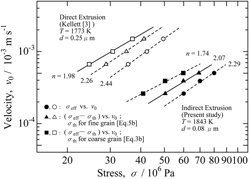No CrossRef data available.
Article contents
Hot extrusion of nanocrystalline yttria-stabilized tetragonal zirconia polycrystals
Published online by Cambridge University Press: 25 October 2016
Abstract

Hot indirect extrusion behaviors of fully dense 3 mol% Y2O3-stabilized ZrO2 polycrystals with a grain size of 80 nm were investigated by using a conical graphite die. During early extrusion at 1843 K and a constant compression stress of 60–80 MPa, the relative moving billet velocity (v0) shows a sharp maximum, followed by a continuous decrease until it reaches a steady-state v0 value. Visual observations of the material flow by using graphite foil markers indicate that the deformation zone at the steady-state v0 is well represented by a spherical velocity field. The decrease in v0 corresponds to the transition from heterogeneous to homogeneous deformation. The stress exponent (n) of 2.07 was obtained from the log–log plots of the steady-state v0 versus the external applied stress that is compensated by threshold and sliding friction stresses. This n value suggests plastic deformation through grain-boundary sliding in indirect extrusion.
- Type
- Articles
- Information
- Copyright
- Copyright © Materials Research Society 2016
Footnotes
Contributing Editor: Yanchun Zhou





